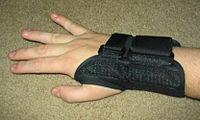
Photo from wikipedia
Objective Musculoskeletal disorders are one of the most important occupational problems especially among nurses. The aim of this study was to investigate the prevalence of musculoskeletal disorders in upper limbs… Click to show full abstract
Objective Musculoskeletal disorders are one of the most important occupational problems especially among nurses. The aim of this study was to investigate the prevalence of musculoskeletal disorders in upper limbs and its associated psychosocial factors in the workplace. Methods A systematic review was conducted by searching the Medline/PubMed, EMBASE, Scopus, ISI/web of knowledge and Google Scholar databases. The authors classified studies into categories of psychological work stressors and musculoskeletal problems. The statistical analysis was performed using Stata software. Results We found 1742 articles in our initial search. After reviewing the titles, abstracts and full texts, 66 articles were finally analyzed. Psychosocial factors affecting the prevalence of upper limb musculoskeletal disorders among nurses were identified which included boring work, inadequate staffing, job demands, insufficient support, time pressure, decision latitude, job dissatisfaction, and job stress. There was a significant relationship between these factors and prevalence of musculoskeletal disorders in the wrists, shoulders, neck and shoulders, and wrists and hands. Conclusion Collectively, the results of this study provide strong evidence of some psychosocial factors affecting the prevalence of upper limb musculoskeletal disorders among nurses. Thus, organizational interventions to minimize these stressors may be promising in reducing one risk factor for the development of nurses’ musculoskeletal disorders. These interventions should not only consider the factors of physical ergonomics but also seek to improve the organizational aspects of the workplace.
Journal Title: International Archives of Occupational and Environmental Health
Year Published: 2021
Link to full text (if available)
Share on Social Media: Sign Up to like & get
recommendations!